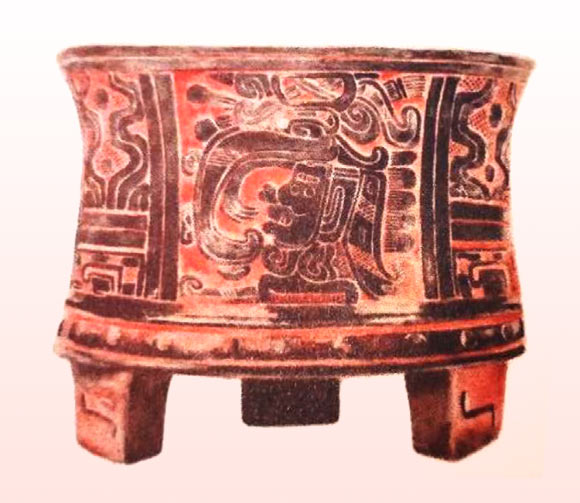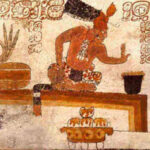The ancient Maya in Mesoamerica used mercury — predominantly cinnabar, but rarely elemental mercury — for decorative and ceremonial purposes, according to a team of archaeologists from Australia, the United States and the United Kingdom.
A cinnabar-painted vessel from the Maya site of Kaminaljuyu in southern Guatemala. Image credit: Kidder et al. / Cook et al., doi: 10.3389/fenvs.2022.986119.
Mercury is a toxic pollutant that affects human and ecosystem health.
Elevated mercury concentrations in the surface systems of our planet are primarily connected with increasing industrialization and urbanization.
Mining and fossil-fuel power generation activities are responsible for at least half of known global mercury emissions today.
The cycling of mercury through the environment is driven by modern emissions such as these, but also includes re-mobilized legacy mercury from past anthropogenic activities.
An important example of a multi-millennial record of mercury use is from present-day Mexico and Central America, where the Maya used mercury for many centuries before European contact in the 16th century.
The possible environmental consequence of this long, region-wide preindustrial mercury use is yet to be investigated.
“Mercury pollution in the environment is usually found in contemporary urban areas and industrial landscapes,” said Dr. Duncan Cook, a researcher at the Australian Catholic University.
“Discovering mercury buried deep in soils and sediments in ancient Maya cities is difficult to explain, until we begin to consider the archeology of the region which tells us that the Maya were using mercury for centuries.”
In the new research, Dr. Cook and his colleagues reviewed all data on mercury concentrations in soil and sediments at Maya archeological sites in lowland Guatemala, Belize, the Yucatan of Mexico, El Salvador, and Honduras.
They found that at the sites of Chunchumil in today’s Mexico, Marco Gonzales, Chan b’i, and Actuncan in Belize, La Corona, Tikal, Petén Itzá, Piedras Negras, and Cancuén in Guatemala, Palmarejo in Honduras, and Cerén in El Salvador, mercury pollution was detectable everywhere except at Chan b’i.
Concentrations ranged from 0.016 ppm at Actuncan to an extraordinary 17.16 ppm at Tikal. For comparison, the Toxic Effect Threshold (TET) for mercury in sediments is defined as 1 ppm.
“The ancient Maya frequently used cinnabar and mercury-containing paints and powders for decoration,” the researchers said.
“This mercury could then have leached from patios, floor areas, walls, and ceramics, and subsequently spread into the soil and water.”
“For the Maya, objects could contain ch’ulel, or soul-force, which resided in blood,” said University of Cincinnati’s Professor Nicholas Dunning.
“Hence, the brilliant red pigment of cinnabar was an invaluable and sacred substance, but unbeknownst to them it was also deadly and its legacy persists in soils and sediments around ancient Maya sites.”
As mercury is rare in the limestone that underlies much of the Maya region, the authors speculate that elemental mercury and cinnabar found at Maya sites could have been originally mined from known deposits on the northern and southern confines of the ancient Maya world, and imported to the cities by traders.
All this mercury would have posed a health hazard for the ancient Maya: for example, the effects of chronic mercury poisoning include damage to the central nervous system, kidneys, and liver, and cause tremors, impaired vision and hearing, paralysis, and mental health problems.
It’s perhaps significant that one of the last Maya rulers of Tikal, Dark Sun, who ruled around 810 CE, is depicted in frescoes as pathologically obese.
Obesity is a known effect of metabolic syndrome, which can be caused by chronic mercury poisoning.
“We conclude that even the ancient Maya, who barely used metals, caused mercury concentrations to be greatly elevated in their environment,” said University of Texas at Austin’s Professor Tim Beach.
“This result is yet more evidence that just like we live today in the ‘Anthropocene,’ there also was a ‘Maya anthropocene’ or ‘Mayacene.’ Metal contamination seems to have been effect of human activity through history.”
The team’s paper was published in the journal Frontiers in Environmental Science.
_____
Duncan E. Cook et al. Novel Insights into Mercury Sources and Behavior in the Surface Earth Environment. Front. Environ. Sci, published online September 23, 2022; doi: 10.3389/fenvs.2022.986119




